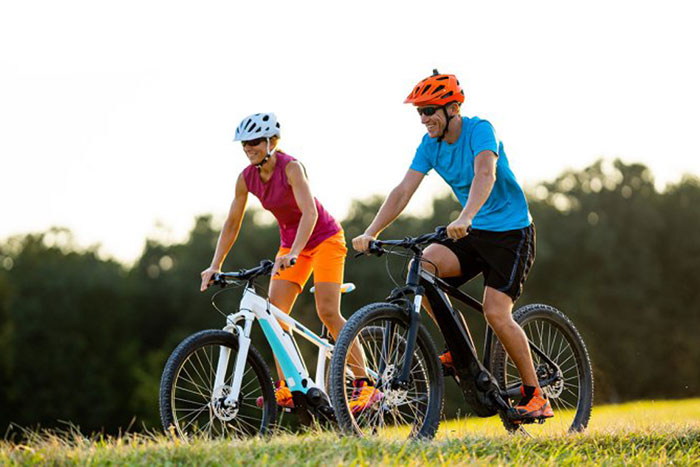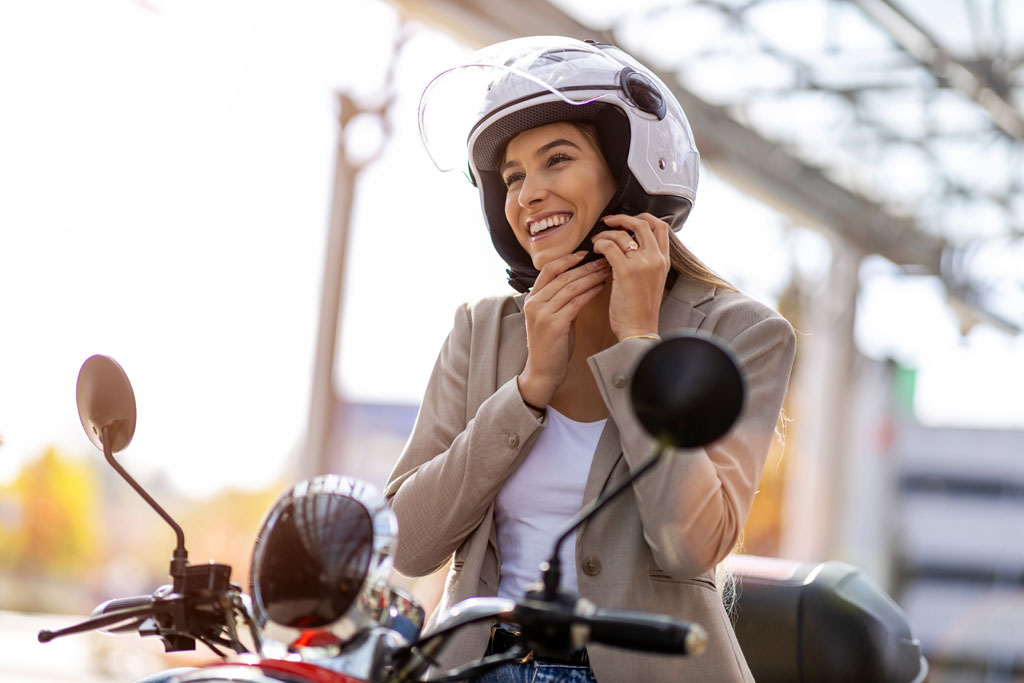The city of Rancho Santa Margarita Police Services has recently developed an e-bike Safety Initiative. This initiative consists of three phases: education, engagement, and enforcement. We are adopting a community-wide approach, involving various stakeholders, including policymakers, e-bike manufacturers, vendors, and school districts, to address these concerns.
E-Bikes
What is an e-bike?
An e-bike is an electric bicycle equipped with fully operable pedals and an electric motor of less than 750 watts.
-
The same rules of the road that apply to human-powered bicycles apply to all types of e-bikes and human-powered bicycles
-
Electric bicycles do not need registration, licensing or insurance like a car or motorcycle
Classes of Electric Bikes

No minimum age
No Driver's License
Helmet required for 17 and under
Where You Can Ride
Class I: Bike path
Class II: Bike lane
Class III: Bike route
Class IV: Bike boulevard
Regulation Rules
Maximum speed 20 mph
Pedal assist only (Class 1)
Pedal and throttle assist (Class 2)

Minimum age 16
No Driver's License
Helmet required for all ages
Where You Can Ride
Class II: Bike lane
Class III: Bike route
Class IV: Bike boulevard
Regulation Rules
Maximum speed 28 mph
Pedal assist

Minimum age 16
Driver's License and registration required
Helmet required for all ages
Where You Can Ride
Street lanes
Regulation Rules
Maximum speed same as vehicles
Pedal and throttle assist
*Mopeds are not E-Bikes but being shown for comparison purposes
Understanding E-Bike Regulations in California
- (1) A “class 1 electric bicycle,” or “low-speed pedal-assisted electric bicycle,” is a bicycle equipped with a motor that provides assistance only when the rider is pedaling, and that ceases to provide assistance when the bicycle reaches the speed of 20 miles per hour.
- (2) A “class 2 electric bicycle,” or “low-speed throttle-assisted electric bicycle,” is a bicycle equipped with a motor that may be used exclusively to propel the bicycle, and that is not capable of providing assistance when the bicycle reaches the speed of 20 miles per hour.
- (3) A “class 3 electric bicycle,” or “speed pedal-assisted electric bicycle,” is a bicycle equipped with a motor that provides assistance only when the rider is pedaling, and that ceases to provide assistance when the bicycle reaches the speed of 28 miles per hour, and equipped with a speedometer.
- (b) A person riding an electric bicycle, as defined in this section, is subject to Article 4 (commencing with Section 21200) of Chapter 1 of Division 11.
- (c) On and after January 1, 2017, manufacturers and distributors of electric bicycles shall apply a label that is permanently affixed, in a prominent location, to each electric bicycle. The label shall contain the classification number, top assisted speed, and motor wattage of the electric bicycle, and shall be printed in Arial font in at least 9-point type.
Vehicle
| Vehicle Type | Pedal Operated | Maximum Assisted-Speed (MPH) |
|---|---|---|
| Bicycle | YES | N/A |
| Type I E-Bike | YES | 20 |
| Type II E-Bike | NO | 20 |
| Type III E-Bike | YES | 28 |
| Moped | NO | N/A |
Rider
| Vehicle Type | Minimum Age (Years) | Driver's License | License Plate | Helmet |
|---|---|---|---|---|
| Bicycle | N/A | NO | NO | 17 and Under |
| Type I E-Bike | N/A | NO | NO | 17 and Under |
| Type II E-Bike | N/A | NO | NO | 17 and Under |
| Type III E-Bike | 16 | NO | NO | YES |
| Moped | 16 | YES | YES | YES |
Bikeway Access
| Vehicle Type | Class I Bike Path | Class II Bike Lane | Class III Bike Route | Class IV Protected Lane |
|---|---|---|---|---|
| Bicycle | YES | YES | YES | YES |
| Type I E-Bike | YES | YES | YES | YES |
| Type II E-Bike | YES | YES | YES | YES |
| Type III E-Bike | NO | YES | YES | YES |
| Moped | NO | YES | YES | NO |
- Class 1 Bike Paths are for the exclusive use of cyclists and pedestrians and are off main roads. Probably the most famous Class 1 Bike Paths are paved roads in nature areas. Only Types 1 and 2 e-bikes can go on Class 1 Bike Paths.
- Class 2 Bike Lanes are the protected one-way bike lanes you see on various streets and highways. You will be able to see lines on the ground designating a Class 2 Bike Lane. All three e-bikes are allowed to use Class 2 Bike Lanes.
- Class 3 Bikeways are on roadways, but they don’t have any special markings on the road and can be used by motorists, pedestrians, and cyclists. Usually Class 3 Bikeways are designated with a sign. Class 3 Bikeways are split into 3A and 3B, where 3A refers to shared lanes on arterial or parallel streets and 3B refers to bikeways in residential areas. All three e-bikes are allowed on Class 3 B
- Class IV Bikeways are like Class II Bikeways, but they are protected from vehicular traffic with either a space or a barrier such as a curb, a parking lane, or a sidewalk. Sometimes people refer to these lanes as “cycle tracks.” Types I, II, and III e-bikes can use these facilities.
21213 (a) A person under 16 years of age shall not operate a class 3 electric bicycle.
(b) A person shall not operate a class 3 electric bicycle, or ride upon a class 3 electric bicycle as a passenger, upon a street, bikeway, as defined in Section 890.4 of the Streets and Highways Code, or any other public bicycle path or trail, unless that person is wearing a properly fitted and fastened bicycle helmet that meets the standards of either the American Society for Testing and Materials (ASTM) or the United States Consumer Product Safety Commission (CPSC), or standards subsequently established by those entities. This helmet requirement also applies to a person who rides upon a class 3 electric bicycle while in a restraining seat that is attached to the bicycle or in a trailer towed by the bicycle. 21211 Bike path obstruction: No one may stop on or park a bicycle on a bicycle path.
21212 (a) A person under 18 years of age shall not operate a bicycle, a nonmotorized scooter, or a skateboard, nor wear in-line or roller skates, nor ride upon a bicycle, a nonmotorized scooter, or a skateboard as a passenger, upon a street, bikeway, as defined in Section 890.4 of the Streets and Highways Code, or any other public bicycle path or trail unless that person is wearing a properly fitted and fastened bicycle helmet that meets the standards of either the American Society for Testing and Materials (ASTM) or the United States Consumer Product Safety Commission (CPSC), or standards subsequently established by those entities. This requirement also applies to a person who rides upon a bicycle while in a restraining seat that is at 21651.
21651 (b) It is unlawful to drive any vehicle upon a highway, except to the right of an intermittent barrier or a dividing section which separates two or more opposing lanes of traffic. Except as otherwise provided in subdivision (c), a violation of this subdivision is a misdemeanor. 10.56.010 (CMC) Riding on sidewalks and public facilities. No person shall ride a bicycle upon any sidewalk, in any public drainage facility, culvert, ditch, or channel; or any other public athletic/sports courts, or gymnasiums in the city. Law enforcement personnel shall be exempt from the provision of this section when in the performance of their duties. (Ord. CS-139 § 1, 2011; Ord. NS-151 § 1, 1991; Ord. 3062 § 8). (Look at 21663 CVC as well)
21453 (a) Red traffic light.
22450 (a) Stop sign.
21461 (a) Railroad crossing, must stop active signal device “R/R Crossing.”
22451 (a) Railroad crossing must stop for active signal device w/ train approaching and horn.
22100 (a) Right turn from improper position.
22107 Unsafe movement, to the left or right.
E-Bike Safety Videos
Partner Agency Efforts
Rules of the Road
Bicyclists and e-bike riders are subject to all the same rules of the road as motorists. Riders who don’t follow the rules are subject to ticketing and fines as defined by the Vehicle or Municipal Code in which they are riding.
Make sure to follow these guidelines:
-
Riders 17 years and under must wear a helmet
-
Traffic lights, signs, and signals apply to all road users, including bicyclists and e-bike riders
-
Cyclists must ride to the right of the road as practicable. If you're riding slower than traffic, ride in the bike lane. You can leave the bike lane to turn left, pass someone, avoid a road hazard or avoid cars turning right
-
You must stop at crosswalks for pedestrians
-
Be aware of other road users and try to match the average speed. This means riding slowly in areas with pedestrians
-
Observe and follow speed limits on Class I bicycle facilities
-
Must stop at red lights
-
Must stop before right turn at red lights
-
Must stop at stop signs
-
Riding against the flow of traffic is prohibited
-
Cyclists must ride to the right edge of road as practicable
-
Proper reflective and lighting equipment must be used during night operation
-
When a bicycle lane is available, bicyclists are required to use the bike lane unless they are traveling as fast as traffic
-
It is illegal to carry passengers on your e-bike unless your bike has an extra permanent seat or when using a child safety seat
-
The "sharrow" symbol below means the lane is too narrow for a bicycle and a motor vehicle to share safely side by side. Bicyclists should discourage unsafe passing by riding towards the middle of this narrow lane. Bicyclists have a right to the road, even if no sharrow is present
Passengers
-
Many e-bikes are not equipped to carry passengers. E-bikes can only transport passengers if there is a designated spot for passengers and transportation can be carried out safely
-
Passengers are required to wear a helmet if they are under 18
-
Class 3 e-bike riders must not transport passengers
Safety
E-bikes are lucrative targets for thieves. Take every precaution to ensure that your e-bike is safe.
-
When done using your bike, put it away - inside if possible and out of site
-
When out and about on your bike, always lock it securely and keep an eye on it
-
Use a good lock. Make sure your lock has a high-security rating and learn to use it wisely
-
Where to lock it? Look for something totally immovable that can't be cut
-
How to lock it? Lock at the lowest point possible between bike frame and the locking object or cycle stand. This makes access and leverage points harder for thieves. Lock the frame and one wheel to the stand
-
If you have parts or components that are easily removed, take them with you
Orange County’s E-Bike Regulations for Trails
E-bikes are prohibited on unpaved trails within regional and wilderness parks. This includes Classes 1-3: More information on e-bikes and mobility device policies.
